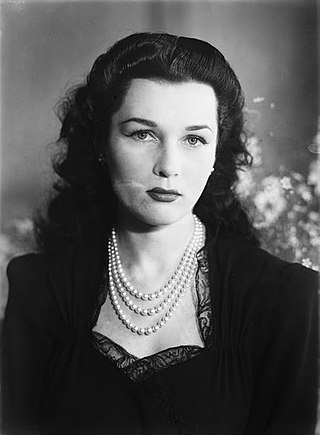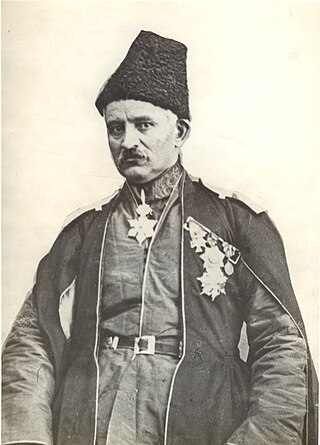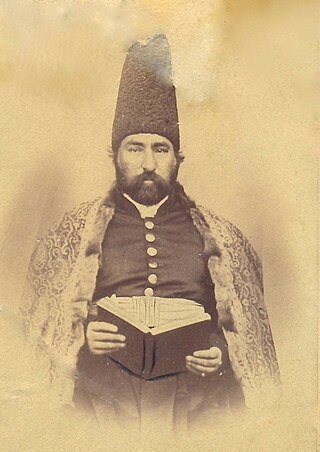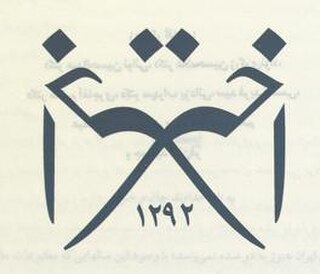Related Research Articles

Fawzia of Egypt, also known as Fawzia Pahlavi or Fawzia Chirine, was an Egyptian princess who became Queen of Iran as the first wife of Mohammad Reza Pahlavi, Shah of Iran.

The Qajar dynasty was an Iranian royal dynasty of Turkic origin, specifically from the Qajar tribe, ruling over Iran from 1789 to 1925. The Qajar family took full control of Iran in 1794, deposing Lotf 'Ali Khan, the last Shah of the Zand dynasty, and re-asserted Iranian sovereignty over large parts of the Caucasus. In 1796, Mohammad Khan Qajar seized Mashhad with ease, putting an end to the Afsharid dynasty, and Mohammad Khan was formally crowned as Shah after his punitive campaign against Iran's Georgian subjects. In the Caucasus, the Qajar dynasty permanently lost many of Iran's integral areas to the Russians over the course of the 19th century, comprising modern-day eastern Georgia, Dagestan, Azerbaijan and Armenia.

Mohammad Ali Shah Qajar, Shah of Iran from 8 January 1907 to 16 July 1909. He was the sixth shah of the Qajar Dynasty.

Mohammad Shah was the third Qajar shah of Iran from 1834 to 1848, having succeeded his grandfather Fath-Ali Shah. From a young age, Mohammad Mirza was under the tutelage of Haji Mirza Aqasi, a local dervish from Tabriz whose teachings influenced the young prince to become a Sufi-king later in his life. After his father Abbas Mirza died in 1833, Mohammad Mirza became the Crown Prince of Iran and was conferred the title of Governor of Azarbaijan. Not long after, Fath-Ali Shah died on his way to Shiraz, leading some of his sons—including Ali Shah Mirza and Hossein Ali Mirza—to revolt but Mohammad Shah, with the support of his grand vizier, Abol-Qasem Qa'em-Maqam, suppressed the rebellions and asserted his authority.

Mozaffar ad-Din Shah Qajar, was the fifth shah of Qajar Iran, reigning from 1896 until his death in 1907. He is often credited with the creation of the Persian Constitution of 1906, which he approved of as one of his final actions as Shah.

Dār ul-Funun, established by the Royal Vizier to Nasereddin Shah in 1851, is the oldest Western-style institute of higher learning in Iran.
Intellectual movements in Iran involve the Iranian experience of modernity and its associated art, science, literature, poetry, and political structures that have been changing since the 19th century.

The Shrine of Fatima Masumeh is located in Qom, which is considered by Twelver Shia Muslims to be the second most sacred city in Iran after Mashhad.

Mirza Fatali Akhundov, also known as Mirza Fatali Akhundzade, or Mirza Fath-Ali Akhundzadeh, was a celebrated Iranian Azerbaijani author, playwright, atheist, philosopher, and founder of Azerbaijani modern literary criticism, "who acquired fame primarily as the writer of European-inspired plays in the Azeri Turkic language".

Mirzā Jahāngir Khān, also known as Mirzā Jahāngir Khān Shirāzi and Jahāngir-Khān-e Sūr-e-Esrāfil, was an Iranian writer and intellectual, and a revolutionary during the Iranian Constitutional Revolution (1905–1911). He is best known for his editorship of the progressive weekly newspaper Sur-e Esrāfil, of which he was also the founder. He was executed, at the age of 38, or 32, for his revolutionary zeal, following the successful coup d'état of Mohammad-Ali Shah Qajar in June 1908. His execution took place in Bāgh-e Shāh in Tehran, and was attended by Mohammad-Ali Shah himself. He shared this fate simultaneously with his fellow revolutionary Mirzā Nasro'llah Beheshti, better known as Malek al-Motakallemin. It has been reported that immediately before his execution he had said "Long live the constitutional government" and pointed to the ground and uttered the words "O Land, we are [being] killed for the sake of your preservation [/protection]".

Mirzā Abdul'Rahim Tālibi Najjār Tabrizi, also known as Talibov, was an Iranian Azerbaijani intellectual and social reformer. He was born in the Sorkhab district of Tabriz, Iran. Both his father, Abu-Tālib Najjār Tabrizi, and grandfather, Ali-Morad Najjār Tabrizi, were carpenters. No information concerning the maternal side of his family is available.

Bahman Mirza was an Iranian prince from the Qajar dynasty. The son of Abbas Mirza and grandson of Fath Ali Shah, he was Vicergerent (vali) of Azerbaijan and Governor-General of Tabriz. He later migrated to neighboring Imperial Russia, where he was received with great honour and lived a prestigious life in Shusha. Many of his offspring either returned to Iran where they pursued political or military careers, or served in the Russian military, and later played an important role in the military of Azerbaijan Democratic Republic. He is also the great-grandfather of Afrasiyab Badalbeyli, Azerbaijani composer and author of the first Azerbaijani balet and the first ballet in the Muslim East.

The Persian periodical Akhtar was published in Constantinople, Ottoman Empire, in the period 1876–1896.

Socialism inIran or Iranian socialism is a political ideology that traces its beginnings to the 20th century and encompasses various political parties in the country. Iran experienced a short Third World Socialism period at the zenith of the Tudeh Party after the abdication of Reza Shah and his replacement by his son, Mohammad Reza Pahlavi. After failing to reach power, this form of third world socialism was replaced by Mosaddegh's populist, non-aligned Iranian nationalism of the National Front party as the main anti-monarchy force in Iran, reaching power (1949–1953), and it remained with that strength even in opposition until the rise of Islamism and the Iranian Revolution. The Tudehs have moved towards basic socialist communism since then.
Hekmat was the first Persian-language newspaper published in Egypt, and the first Persian journal published in an Arab country. Founded and managed by the Iranian expatriate Mohammad-Mahdi Tabrizi, a physician by profession, it was published from 20 September 1892 until 30 May 1911. Hekmat carried primarily news, but also featured a variety of articles on political and social issues. Despite being published in an Arab country, it avoided using Arabic terms and Arabic forms of non-Arab words in its content.

The Iranian Enlightenment, sometimes called the first generation of intellectual movements in Iran, brought new ideas into traditional Iranian society from the mid-nineteenth to the early twentieth century. During the rule of the Qajar dynasty, and especially after the defeat of Iran in its war with the Russian Empire, cultural exchanges led to the formation of new ideas among the educated class of Iran. This military defeat also encouraged the Qajar commanders to overcome Iran's backwardness. The establishment of Dar ul-Fonun, the first modern university in Iran and the arrival of foreign professors, caused the thoughts of European thinkers to enter Iran, followed by the first signs of enlightenment and intellectual movements in Iran.

The Principality of Herat, the Emirate of Herat, the Herat Khanate or simply Herat was a state in Afghanistan from 1793 to 1863, and one of the 3 main khanates in 19th century Afghanistan.

Qanun was a monthly newspaper which was published in London during the period 1890–1898. The founder and editor of the paper was Mirza Malkam Khan who served as the Qajar Iran's envoy to Britain and Italy. It is known to be the first oppositional publication of Iran and was one of the publications which improved the political awareness of Iranians.
Sorayya was one of the Persian publications which were published in Cairo, Egypt. The paper was the second Persian newspaper published there and was in circulation between 1898 and 1900. It was among the Persian publications published abroad which contributed to the political awakening of Iranians.
Mirza Mohammad Taqi Sepehr, also known as Mirza Mohammad Taqi Kashani, or with the honorific Lesan ol-Molk, was an Iranian court historian and littérateur of the Qajar era. He wrote with the pen name Sepehr, and is known for authoring the lengthy Persian chronicle Nasekh ol-tavarikh-e salatin-e Qajariyeh, also simply known as the Nasekh ol-tavarikh.
References
- 1 2 3 Nassereddin Parvin (2009). "Persian Journalism in Egypt". Encyclopædia Iranica .
- ↑ Amin Banani (1959). Impact of the West on Iran, 1921-1941: A study in modernization of social institutions (PhD thesis). Stanford University. p. 16. ISBN 9781084919372. ProQuest 301883678.
- ↑ Hanan Hammad (2014). "Relocating a common past and the making of east-centric modernity: Islamic and secular nationalism(s) in Egypt and Iran". In Kamran Scot Aghaie; Afshin Marashi (eds.). Rethinking Iranian Nationalism and Modernity. Austin, TX: University of Texas Press. p. 279. ISBN 978-0-292-75749-3.
- 1 2 Kamran M. Dadkhah (July 1992). "Lebas-o Taqva: An Early Twentieth-Century Treatise on the Economy". Middle Eastern Studies . 28 (3): 550. doi:10.1080/00263209208700914.
- ↑ Gholam Hossein Razi (Autumn 1968). "The Press and Political Institutions of Iran: A Content Analysis of "Ettela'at" and "Keyhan"". The Middle East Journal . 22 (4): 463–474. JSTOR 4324340.
- 1 2 3 Parvin Paidar (1997). Women and the Political Process in Twentieth-Century Iran. Cambridge: Cambridge University Press. pp. 47–48. ISBN 978-0-521-59572-8.